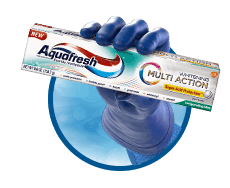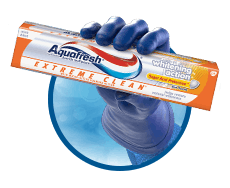How Long Should You Brush Your Teeth?
If you’re dedicated to keeping up with proper oral hygiene, you may be wondering how long you should brush your teeth to ensure that they’re properly cleaned. How long is too long, and what if you’re not brushing for long enough? The answer is actually both simple and straightforward.

How long should you take to brush your teeth?
The American Dental Association recommends that you brush your teeth for two minutes, twice a day with fluoride toothpaste and a soft-bristled toothbrush.1, 7 This length of time ensures that you will have paid thorough attention to all your teeth, and regularly doing so will help you have strong, healthy teeth for years to come.
Why you should brush your teeth for two minutes
The act of brushing your teeth helps to get rid of daily buildup of plaque, a sticky film of bacteria2 which can form as a result of eating starches and sugary foods, and will build up if teeth are not cleaned properly.3 Plaque buildup can lead to several dental issues down the road like tartar, tooth decay, and gum disease.4
By properly brushing your teeth for two minutes twice a day and flossing, or using another form of interdental cleaner to clean in between your teeth, you can effectively brush away the plaque that has built up overnight or during the day. Brushing for longer than two minutes is fine but take care not to irritate your gums by brushing too hard. So, if you’re wondering how long you should brush your teeth for, aim for at least two minutes every time you pick up a tooth brush.
What else should you do to take care of your teeth?
While it is incredibly important to keep in mind how long you’re brushing your teeth, it’s not the only thing you can do to make sure your smile is in great shape.
· Brush correctly.
There’s actually a technique for correctly brushing your teeth. Remember to use a soft-bristled toothbrush and brush in short strokes about the width of one of your teeth. Keep your brush at a 45-degree angle and make sure to hit all the angles of your teeth—front, back, and tops.
· Floss.
If brushing removes plaque from the outer surfaces, inner surfaces, and the chewing/biting surfaces of your teeth, flossing—or using another form of interdental cleaners (such as dental picks, string floss, tiny brushes that reach in between the teeth and water flossers—helps to remove plaque from between your teeth where a toothbrush’s bristles won’t reach. This helps to prevent tooth decay, gum disease, and bad breath.· Use fluoride toothpaste.
Acids from plaque bacteria can lead to tooth decay; brushing with a fluoride toothpaste can help protect against plaque acid attack.5 Using a fluoride toothpaste can also help provide cavity protection.· Use mouthwash after brushing and flossing.
Like floss or another type of interdental cleaner, mouthwash can reach parts of the tooth that cannot be reached by a toothbrush and can help control plaque and gingivitis.6 Some types of mouthwash contain fluoride, which can help strengthen teeth.6· Visit your dentist regularly.
Regular teeth cleanings by a professional can help ensure that your smile is always in perfect shape. Your dentist can clear away hardened plaque, also known as tartar, and keep you in the loop about issues you may not have been aware of. They can make recommendations about products and techniques you should try, and can show you where you need to focus in your hygiene routine.
Dental hygiene is important!
You only get one set of teeth as an adult. If you take good care of them, they’ll last your whole life! So even if you don't add mouthwash to your routine, make sure to clean in-between your teeth once daily and brush them twice a day for two minutes at a time..
- Oral Health Topics. American Dental Association. https://www.ada.org/en/member-center/oral-health-topics/toothbrushes. Accessed on 2/5/2021. Referenced text is highlighted in the PDF.
- Periodontal (Gum) Disease. National Institute of Dental and Craniofacial Research. https://www.nidcr.nih.gov/health-info/gum-disease/more-info. Accessed on 2/5/2021. Referenced text is highlighted in the PDF.
- Cavities / Tooth Decay. Mayo Clinic. https://www.mayoclinic.org/diseases-conditions/cavities/symptoms-causes/syc-20352892. Accessed on 2/5/2021.
- When and how often should you brush your teeth. Mayo Clinic. Referenced text is highlighted in the PDF. https://www.mayoclinic.org/healthy-lifestyle/adult-health/expert-answers/brushing-your-teeth/faq-20058193. Accessed on 2/5/2021.
- How does the fluoride in toothpaste prevent cavities? Scientific American. Referenced text is highlighted in the PDF. https://www.scientificamerican.com/article/how-does-the-fluoride-in/. Accessed on 2/5/2021. Referenced text is highlighted in the PDF.
- Mouthwash. American Dental Association. https://www.ada.org/en/member-center/oral-health-topics/mouthrinse. Accessed on 2/5/2021. Referenced text is highlighted in the PDF.
- Brushing Your Teeth. Mouth Healthy. https://www.mouthhealthy.org/en/az-topics/b/brushing-your-teeth. Accessed on 8/19/2021. Referenced text is highlighted in PDF.
Do My Teeth Look Brown To You?




Aquafresh® Multi Action® Whitening can help brighten your smile in no time.

Get 75¢ off any one Aquafresh® product.

Check out more from Captain Aquafresh® to learn how to fight cavities.

Learn more about your oral health and how Aquafresh® helps keep you feeling clean.






